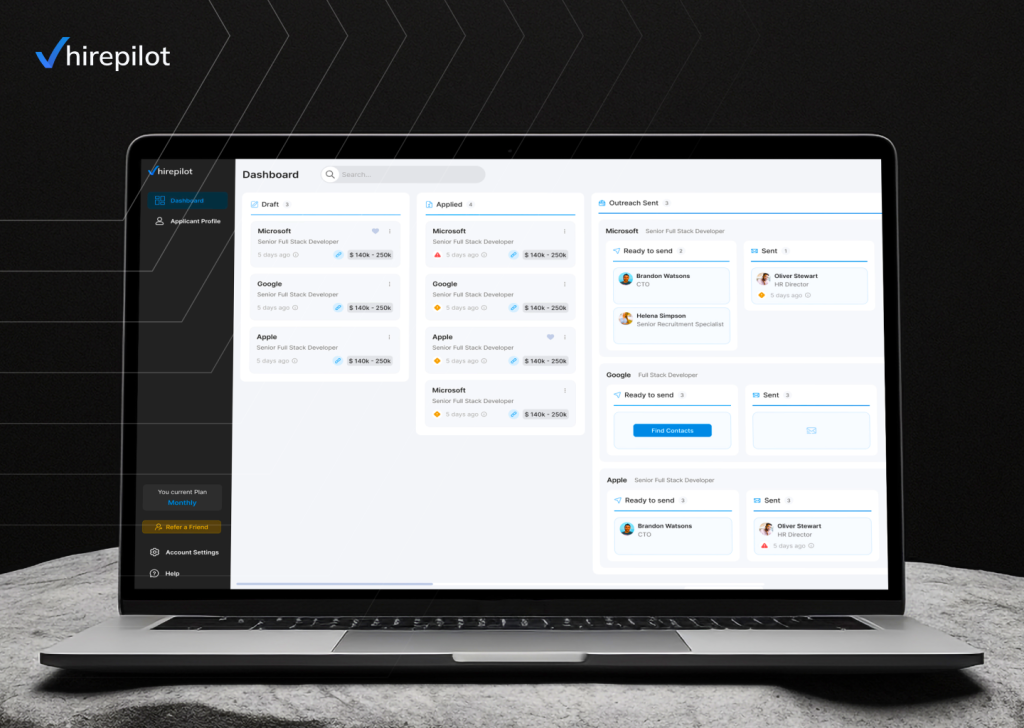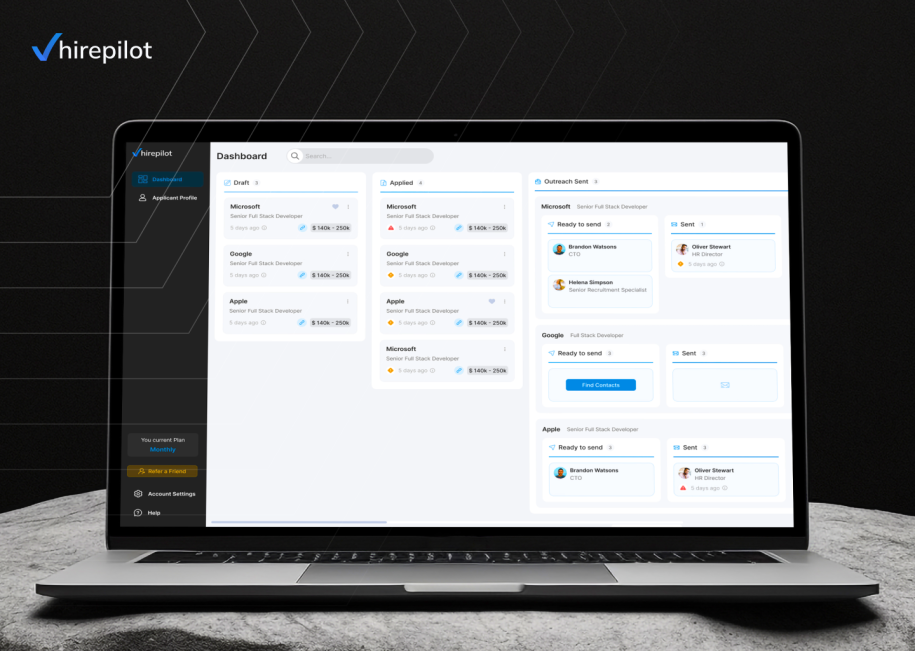Searching for a job in today’s market is overwhelming. Applicants often juggle dozens, or even hundreds, of applications at the same time. Without a system, the process quickly turns chaotic: missed deadlines, duplicate applications, forgotten recruiter names, and lost opportunities.
This is where job application tracker benefits truly shine. A tracker helps you organize everything in one place, reduces stress, and improves your chances of landing interviews. Instead of drowning in sticky notes, spreadsheets, or scattered email folders, you get clarity and structure.
In this guide, we’ll explore the real challenges job seekers face, the key benefits of using a structured job application tracker, how modern AI tools go beyond spreadsheets, and why these benefits matter if you want to secure your next role faster.
The modern job hunt, why applicants lose track
Job hunting today looks very different compared to even a decade ago. Online platforms allow you to apply to dozens of roles in minutes. While that sounds like progress, it creates its own set of problems:
- Duplicate applications. Many job seekers apply multiple times to the same company through different portals without realizing it.
- Missed follow-ups. Recruiters expect candidates to stay engaged, but without reminders, you may forget to check back.
- Forgotten contacts. Networking is key, yet most people lose track of who they spoke with and when.
- Deadline overload. Application forms, assessments, and interviews each have unique deadlines. Missing just one can cost you an opportunity.
A job application tracker solves these challenges by giving you a single dashboard where everything is logged and easy to review. Instead of searching through emails or scribbled notes, you know exactly where you stand with each role.

Top challenges without a job application tracker
Trying to “just remember everything” or use a messy spreadsheet often leads to these common problems:
- Disorganization. When information is scattered across emails, notes, and tabs, things fall through the cracks.
- Time waste. Manually searching through inboxes or retyping details costs valuable hours.
- Stress overload. The mental load of trying to keep track of applications adds unnecessary anxiety.
- Missed opportunities. Forgetting deadlines or failing to follow up can result in lost interviews.
While some people use a job application tracker spreadsheet or an Excel template, these still require manual updates. They lack the automation, reminders, and insights you get from modern tools.
Using a structured job application tracker means no more chasing chaos—you can focus on preparing for interviews instead.
Benefits of using a structured job application tracker
So why do job application tracker benefits matter so much? Let’s break down the advantages that directly impact your job search success:
1. Centralized Organization
Every application is logged in one place: the role title, company, recruiter contact, application date, and current status. You no longer have to scroll through your inbox or search through old notes.
2. Follow-Up Reminders
Recruiters often expect candidates to follow up within 7–10 days. A good tracker helps you schedule reminders so you never forget. Following up politely can double your chances of landing an interview.
3. Reduced Duplicate Efforts
Applying twice to the same company or role looks unprofessional. A tracker prevents accidental duplicates and keeps your job search streamlined.
4. Improved Communication
By recording recruiter names, LinkedIn profiles, and email addresses, you always know who to contact and when.
5. Better Decision-Making
When you see all applications in one view, it’s easier to prioritize which roles to pursue, which companies are most responsive, and where to focus your energy.
Using a job application tracking system also gives you more control, something job seekers often lose in the chaos of modern hiring.
Learn more in our full guide on The Ultimate Job Application Tracker.

Time & Productivity, the underrated job application tracker benefits
Most candidates underestimate how much time they lose to manual admin. A structured job application tracker turns that hidden work into a repeatable routine.
Micro-automations that add up: auto-fill saves 5-15 minutes per form; with 40-60 applications that’s 4-12 hours back. One-click follow-up reminders replace calendar juggling. Reusable snippets for cover letters and screening questions cut copy-paste fatigue.
Weekly batching beats context switching:
- Mon/Tue: source roles and save them to the tracker.
- Wed/Thu: tailored applications + outreach.
- Fri: follow-ups, pipeline clean-up, quick metrics.
Prioritization: a pipeline view shows where momentum is (applied → interview → offer). You’ll spot stuck roles and re-allocate effort to outreach instead of blindly adding more submissions.
The mental health angle, less stress, more clarity
Job hunting isn’t just a logistical challenge, it’s an emotional one. Constant rejection or silence from employers can feel draining, especially when you don’t have visibility into your progress.
Job application tracker benefits include more than organization, they help protect your mental health:
- Less anxiety. Knowing you’ve logged every role means you won’t lie awake wondering, “Did I already apply there?”
- Clarity brings confidence. A structured system shows you real progress. Even if you haven’t landed a job yet, you can see the interviews you’ve secured and the contacts you’ve made.
- Reduced burnout. Instead of juggling chaos, you work through a clear plan.
As psychologists note, organization reduces stress by lowering cognitive load.
A tracker doesn’t just improve your job search, it improves your overall well-being.
For more strategies on staying resilient during a tough job search, read How to Rebuild Confidence After Constant Rejections.
From spreadsheets to AI job application trackers
Many job seekers start with free tools like Excel or Google Sheets. These are useful, but they have limitations:
- Manual entry is time-consuming.
- No automatic reminders.
- No insights into response rates or recruiter engagement.
That’s why the rise of AI job application trackers has changed the landscape. AI tools can:
- Auto-fill repetitive application forms.
- Suggest optimized follow-up times.
- Provide analytics (e.g., which companies respond fastest).
- Integrate with job boards and LinkedIn.
Pairing an AI job application tracker with smart outreach strategies, like those we cover in How to Reach Hiring Managers with AI, can further boost your chances.
Examples:
- Google Sheets job application tracker → useful for beginners, but limited.
- Notion job application tracker → customizable, but still manual.
- AI-powered trackers like HirePilot → automation, reminders, dashboards, and insights.
External source: Forbes: How AI Tools Are Changing the Job Search.
Using AI doesn’t just save time, it ensures consistency and boosts your chances of staying on top of every opportunity.
Quick setup workflow (6 steps) for your job application tracker
- Fields: Company, Role, Location, Source, Application date, Status (Saved/Applied/In review/Interview/Offer/Rejected), Recruiter/HM, Next action + due date, Notes.
- Naming: Company – Role – Level (Month) for easy filtering.
- Intake: save roles straight from boards (title, company, link). Avoid “open-tab limbo”.
- Apply with context: log 2–3 role keywords and why you’re a fit; it speeds tailoring and interview prep.
- Follow-up rules: T+7 days after applying; 24h thank-you after interviews; T+10-14 days final check-in for “In review”.
Weekly review (30-45 min): close stale roles, escalate promising ones, and track three metrics, response rate, interview rate, offer rate.
Case studies: How job application trackers improve results
To understand the real-world impact, let’s look at what happens when job seekers switch from manual tracking to a structured system:
- Case 1: Sarah, marketing professional. Before using a tracker, she applied to 120 jobs in 3 months and forgot to follow up on half of them. After adopting a tracker, she set reminders, and within one month she booked 5 interviews.
- Case 2: Daniel, software engineer. He used spreadsheets but often missed deadlines. With an AI job application tracker, he not only kept track but also auto-filled repetitive applications, saving hours each week.
This mirrors the process we described in The Fastest Way to Apply for Jobs Online.
- Case 3: HirePilot users. Early testers reported they felt “in control” of their search for the first time. Clarity turned chaos into a step-by-step plan.
These examples highlight that job application tracker benefits aren’t abstract, they translate into more interviews, faster responses, and a smoother job search. For instance, Business Insider recently reported on over 750 job seekers feeling frustrated by prolonged job searches and lack of responses after applying, which mirrors what happens without proper tracking. Business Insider: Prolonged Job Searches Leave Candidates FrustratedBusiness Insider
HirePilot’s approach to job application tracking
Traditional tools like spreadsheets and notes can help you stay somewhat organized, but they still leave too much room for error. Missed deadlines, forgotten contacts, and repeated applications remain common. That’s why many job seekers are turning to AI-powered solutions like HirePilot.
HirePilot combines the core job application tracker benefits, organization, reminders, and clarity, with smart automation features designed for today’s competitive market:
- Auto-fill applications. No more wasting 20 minutes on repetitive forms.
- Centralized dashboard. Every role, status, recruiter contact, and follow-up in one place.
- Smart reminders. Never miss an interview or a follow-up email again.
- Analytics & insights. Track which companies respond faster and where your applications are moving forward.
Instead of juggling multiple systems, HirePilot creates a step-by-step plan for your job search. This clarity is exactly what turns chaos into progress.
Why job application tracker benefits matter
At first glance, using a job application tracker may feel optional, something “nice to have.” But the reality is different. With hundreds of applicants for each role, small mistakes, like missing a deadline or forgetting to follow up, can cost you the job.
That’s why job application tracker benefits matter:
- They save time.
- They reduce stress.
- They help you stay consistent.
- They improve your chances of landing interviews.
Job seekers today can’t afford to rely on memory or messy spreadsheets. Structured tools aren’t just about convenience, they’re about staying competitive.
FAQ: Job application tracker benefits
1. How do I keep track of job applications?
You can use spreadsheets or notes to log the jobs you’ve applied to, but they require constant manual updates and can easily become messy. A dedicated job application tracker gives you a centralized place to record every role, deadline, and recruiter contact. It also adds reminders and progress tracking so you always know where you stand in the hiring process. This helps you stay consistent and avoid losing track of important opportunities.
2. What are the benefits of a job application tracker?
The main benefit is organization, you have every detail about your applications in one place. It also reduces stress by giving you clarity and a structured plan, rather than juggling dozens of notes or emails. With reminders built in, you never forget follow-ups, which can improve your response rate from recruiters. Overall, these tools give you more confidence and increase your chances of landing interviews.
3. Is Excel or Google Sheets enough for tracking job applications?
Spreadsheets like Excel or Google Sheets are a good starting point, especially if you’re applying to a small number of jobs. However, they lack built-in reminders, analytics, and automation, which means you still spend time updating everything manually. As your job search grows, the risk of errors and missed deadlines increases. That’s why many job seekers eventually switch to AI-powered tools like HirePilo for more reliability and efficiency.
4. What is the best job application tracker template?
Google Sheets and Excel templates are popular because they’re free and customizable. You can log company names, positions, and dates, but you need to update them manually and set your own reminders. AI tools like HirePilot go beyond templates by offering dashboards, alerts, and smart suggestions to improve your workflow. For serious job seekers, this combination of structure and automation saves both time and effort.
5. Why use an AI job application tracker?
AI trackers bring automation and intelligence that spreadsheets can’t match. They can auto-fill repetitive forms, suggest when to follow up, and provide insights into how your applications are progressing. This means you spend less time on manual work and more time preparing for interviews. In a competitive job market, these advantages can be the difference between getting noticed or being overlooked.
Discover how HirePilot helps you manage job applications with clarity, structure, and confidence.
